4th Gen Primary RGB Tandem OLED Monitors Are Here! – Gigabyte MO27Q28G Showcase
Originally published 16 August 2025, last updated 23 September 2025
Disclaimer: this article includes sponsored promotion, but all content, opinions and commentary are our own.

Introduction
One of the most exciting pieces of news coming out of Computex 2025 in May was the announcement from Gigabyte of their new MO27Q28G monitor. It’s a 27″ OLED monitor with a 2560 x 1440 resolution and a 280Hz refresh rate, and while it doesn’t have the headline-grabbing specs of something like the new 500Hz models (including their own AORUS FO27Q5P) it offers something equally interesting to those who are considering buying an OLED monitors or who follow the market developments.

This was the first monitor in the World to be announced featuring a new, 4th Gen WOLED panel from panel manufacturer LG.Display, with a range of technological improvements expected to boost screen performance. You might have heard about these new 4th Gen panels under various marketing names, including ‘Primary RGB Tandem’, ‘META 3.0’ and ‘4th Gen WOLED’. They all refer to the same thing, and that’s a new step-change in the OLED panel market.
In this article we wanted to break down what all this actually means, what is new and improved, why people are excited about these new technologies and then showcase the Gigabyte MO27Q28G in more detail. We’re expecting this screen to arrive with us in the near future for a full review which will be coming soon as well, so consider this a teaser ahead of that being published soon once all our testing is complete.
- Our full review of the Gigabyte MO27Q28G is also now available here.
What is 4th Gen WOLED?

LG.Display are one of the two primary producers of all OLED panels in the display market, not to be confused with LG Electronics who produce actual TVs and monitors, along with other electronic products. For 2025 LG.Display have announced the development and production of their 4th generation of OLED technology, a technology also sometimes referred to as ‘WOLED’ (for “white OLED” due to its inclusion of a white-sub-pixel. More on that later.)
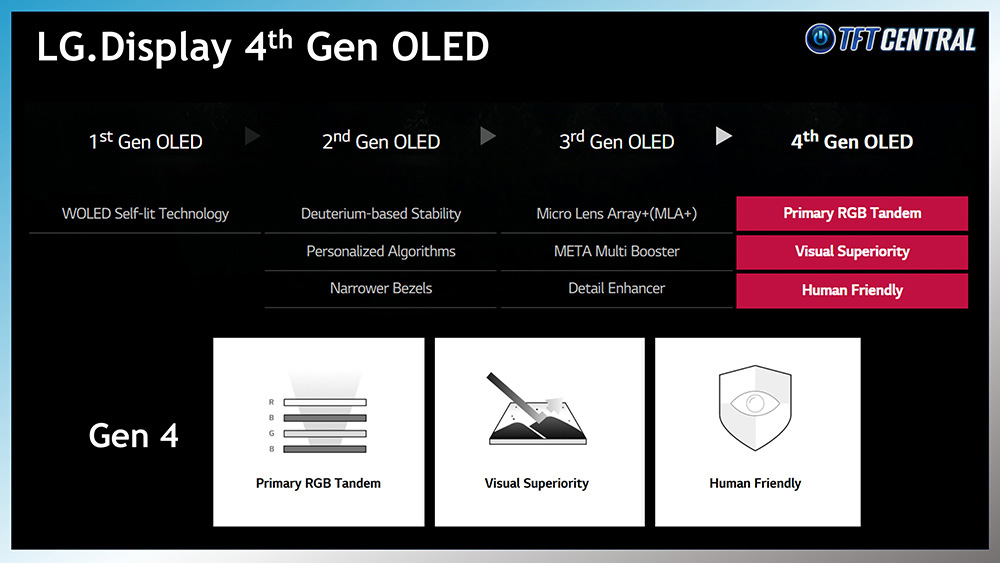
Over the years they’ve improved their OLED technology through updates to the organic materials, panel structure, screen coating and other enhancements, and this year marks the fourth significant step-change. When they originally announced this new generation towards the start of 2025, the headlines were mostly focused around the TV segment, but they’ve been working on bringing the same technological enhancements to their monitor panels.
A New 4-stack Panel Structure

The fundamental change this year for their 4th Gen technology is the shift from a 3-stack panel structure, to 4-stack. This is what they are calling a ‘Primary RGB Tandem’ panel structure. Last year’s Gen 3 panels had a stacked 3-layer structure of light omitting layers, with 2 blue layers sandwiching a combined layer with red and green elements.
For Gen 4 they’ve separated that combined layer in to two distinct red and green layers which can omit their own light, giving 4 stacked layers in total. With the 2 existing blue layers now paired with the separate red and green layers, they’ve created that so-called ‘Primary RGB Tandem’ structure. It’s a marketing term of course, but that’s what they mean by that, and it’s a term you’ll see widely used when talking about their 4th Gen panels.
Note also that with this new panel structure, they’ve also done away with the Micro Lens Array (MLA) that featured heavily on their Gen 3 panels over the last couple of years and was used to maximise brightness on those previous panels.

Quite conveniently the number of layers matches the panel generations, so they’ve gone from 3 layers in Gen 3 to 4 layers in Gen 4 which makes this all a bit easier to remember. Although in some places you may see these panels referred to as ‘META 3.0’ well, which messes up this convenient numbering scheme annoyingly. Let’s just stick to calling it Gen 4 for ease which seems to be their primary marketing name anyway for the latest 2025 panels.
Pixel Layout
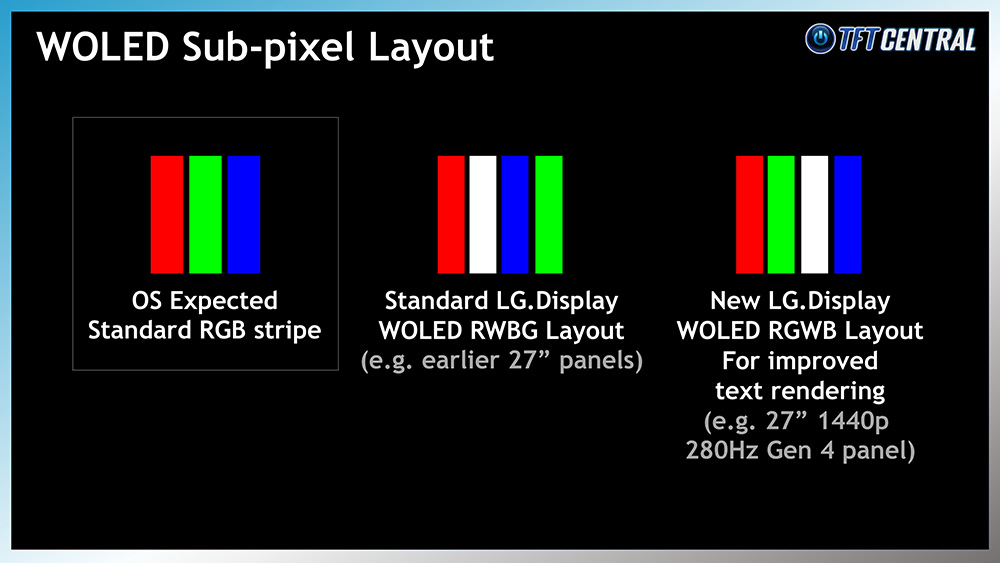
Note that the term ‘Primary RGB Tandem’ refers to the structure of the actual light-emitting layers of the OLED panel, not to the pixel structure of the panel. It does not refer to a true RGB stripe sub-pixel layout and for the time being LG.Display continue to use an additional white sub-pixel alongside the usual RGB sub-pixels to help with panel brightness.
The new 4th Gen WOLED panels will however feature their improved sub-pixel layout, putting the red, green and blue back in their correct order and moving the white sub-pixel to be third in the order. This improved RGWB layout is superior to the old RWBG, where the white sub-pixel was in second place, and the red, green and blue were out of their usual order. This helps improve text clarity nicely, something we’ve tested in the past on other RGWB panels. LG.Display continue to explore true RGB sub-pixel structures for the future, and the latest information we have on those panels is covered in this video.
The Benefits of 4th Gen WOLED Technology
The main benefits that these new 4th Gen panels bring is with brightness and colours. Since we’re focusing on the monitor space here, we’ll talk about the improvements that we can expect from these new panels.

If you want to know more about the enhancements and specs in the TV market, you can find more information in our video here.

SDR luminance increased by up to 34%
For SDR usage the typical spec offered so far has been 250 nits, with a few newer models offering 275 nits max. Typical real-world performance reaches around 270 to 280 nits maximum when using the screens in a uniform brightness mode from our testing. Most are rated at 250 – 275 nits in the monitor specs though which is the easiest figure to compare here when looking at future monitors.
The latest generation OLED monitors promise an increase to SDR brightness for this year with these new LG.Display’s WOLED panels offering an increase up to 335 nits. That’s an increase of 22 – 34% in luminance specs, or an 8 – 13% perceived brightness improvement (based on XCR scores and assuming a D65 white point). Future testing will reveal whether performance is any higher than this of course.
HDR luminance now up to 1500 nits peak
The 4th Gen WOLED panels will offer a reasonable 15% increase in peak luminance (1.5% APL) from the current 1300 nits max spec we’ve seen before, to 1500 nits. That’s as well as improvements at other APL that will impact real-world brightness too.
LG.Display don’t provide specs for 10% APL but we’ve seen recent previous gen WOLED panels reach 700 to 800 nits for white luminance already in our testing and we’d expect improvements with the new panels which we will explore in our upcoming review of the Gigabyte MO27Q28G in the near future.
We do know that full screen 100% APL luminance will increase from a spec of 275 nits max today to at least 335 nits with the new panels, an improvement of 22% luminance, or an 8% perceived brightness increase (based on XCR scores and assuming a D65 white point).
Certification under the VESA DisplayHDR 500 True Black tier

These improvements in HDR brightness will also allow these new 4th Gen WOLED monitors to be certified under the VESA DisplayHDR 500 True Black tier, a step up in brightness requirements compared to all the True Black 400 OLED monitors that have been released to date. We’re seeing some QD-OLED panels released that meet this tier as well, including Gigabyte’s upcoming 500Hz FO27Q5P, although the actual real-world brightness performance will likely be different between the two technologies. We’ll be able to compare that in our upcoming reviews.
Energy saving benefits
Other benefits LG.Display are promoting besides the brightness improvements are around energy saving. By enhancing the fourth-generation OLED panel’s structure and power supply system, they have reduced the panel temperature and achieved around 20% greater energy efficiency than the previous generation, in the case of a 65-inch TV panel example at least. There should be equivalent energy saving benefits in the monitor space and we are seeking clarification on specs from Gigabyte which we will update here.
Improved black depth and ambient light handling
LG.Display are also promoting what they call the “visual superiority” of their 4th Gen OLED technology. We already know that black depth is superior to QD-OLED panels in brighter room environments which is a well-known limitation with the competing Samsung Display technology. The WOLED panels retain their black depth better as ambient lighting increases, something we’ve already seen on previous WOLED panels and measured in detail.
This year for Gen 4 panels LG.Display has also developed a special ‘ultra anti-reflection filter’ for their TV panels that offsets both light reflected from the display’s surface and light absorbed and reflected inside the panel. They say that the new panels block 99% of internal and external light reflections, helping to realize perfect black whether you have the lights off or are using the screen during the daytime in a bright room. There’s expected to be similar benefits with the monitor panels which we will test in detail soon.
Colour gamut improvements

Colour gamut has also been improved with the new 4th Gen WOLED panels and the shift to a 4 layer structure which increases the colour purity and separation, with LG.Display talking about a minor increase in the spec from 98.5% to 99.5% DCI-P3 coverage. But using the DCI-P3 reference space is really a rather limited spec to rely on at this stage and doesn’t fully reflect the improvements, especially when you’re only talking about absolute coverage instead of relative coverage. Using Rec.2020 as a reference colour space, or considering colour volume models should reveal a more detailed picture of the improvements.
Early independent testing in the TV space has revealed an increase in Rec.2020 coverage from around 75% to around 83% for instance between Gen 3 and Gen 4 panels. This should open up support for wider colour spaces where needed for HDR, and offer a more vivid, colourful and saturated image than previous WOLED panels.
‘Human Friendly’ technologies

The other promoted benefit of Gen 4 OLED is what LG.Display are referring to as the “Human friendly” technologies, with the panels being certified for low blue light levels, flicker free operation and glare free comfort. They also have a focus on environmental impact of their products that they’re keen to highlight. This shows their continued focus on eye health, biorhythms and the environment.
Removal of the MLA layer

The removal of the MLA (Micro Lens Array) layer, no longer needed for the brighter Gen 4 panels, is also expected to have some small benefits. This can cause some slight raising of blacks in the presence of ambient lighting and even some very minor graininess when the panels are examined up close. Removing the MLA layer should help improve these areas.
A closer look at the Gigabyte MO27Q28G

That brings us nicely on to the Gigabyte MO27Q28G, the first monitor to be announced this year that will feature a new 4th Gen Primary RGB Tandem WOLED panel. We expecting the screen to arrive with us in the near future for a full review, so stay tuned for that. You can find some coverage of this monitor when it was announced at Computex in May 2025 in our video here.
- Our full review of the Gigabyte MO27Q28G is also now available here.
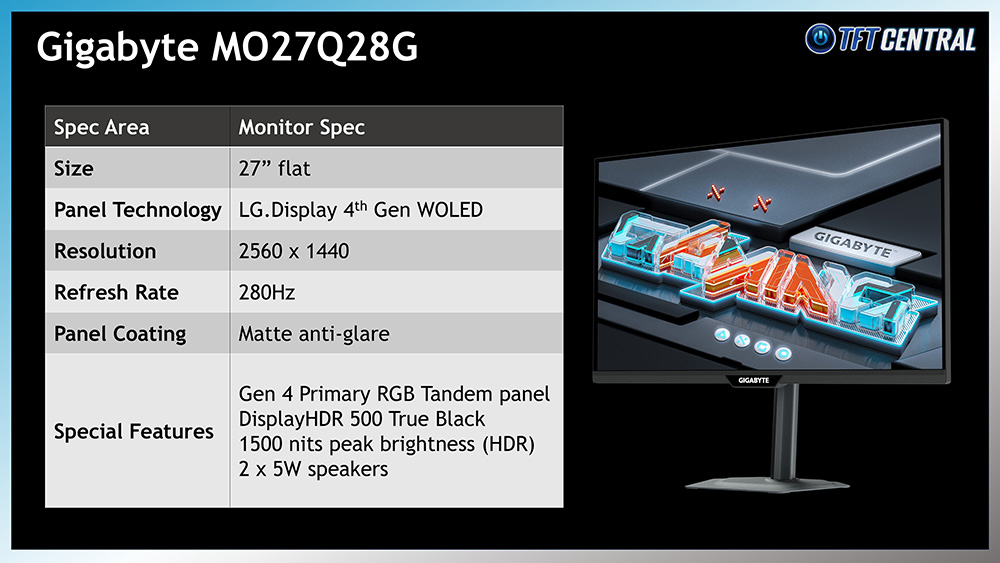
We’ve already talked about some of the specs when discussing the new panel, but this is a 26.5″ (27″ class) sized screen, with a flat format, 16:9 aspect ratio, 2560 x 1440 resolution and a 280Hz refresh rate. We know that it will also offer a 0.03ms G2G response time spec, 1.5 million:1 contrast ratio, 178/178 viewing angles and a 10-bit colour depth.
The screen has a matte anti-glare coating as standard for WOLED panels, although we’re keen to see if any changes or improvements have been made in that area for the new panels when it comes to grain levels, reflection handling and black depth retention. Gigabyte say this tackles 99% of reflections.
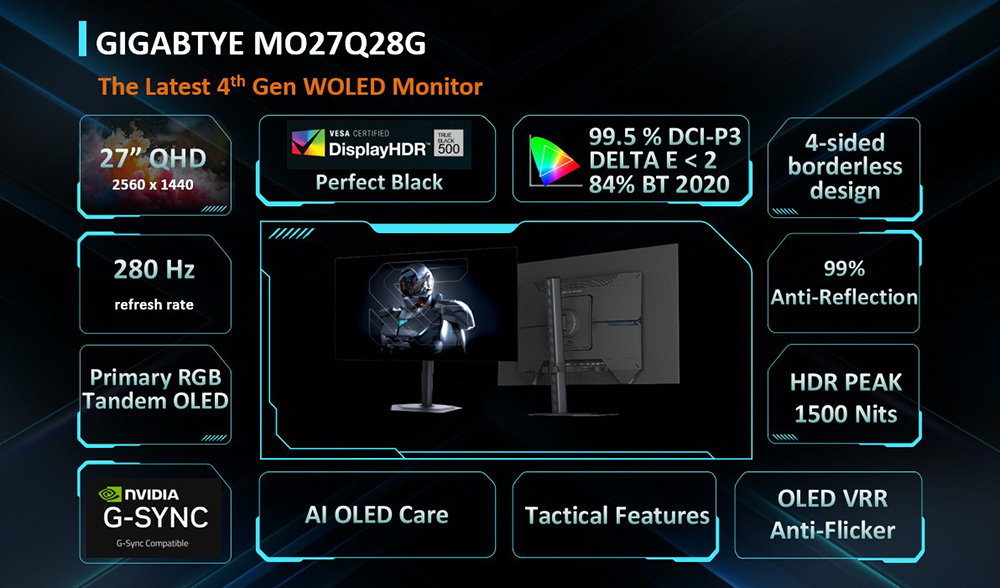
Variable refresh rates, BFI and anti-flicker
The 280Hz refresh rate is supported by adaptive-sync for variable refresh rates (VRR) from compatible systems, with the screen expected to receive certification under the AMD ‘FreeSync Premium Pro’ and NVIDIA ‘G-sync Compatible’ schemes ready for release.
Gigabyte have also added their new ‘VRR Anti-flicker’ modes to this screen to help reduce flickering in those situations, a phenomenon we explored in detail recently. An ‘Ultra Clear’ BFI (Black Frame Insertion) mode is also available for improving motion clarity in non-VRR situations at lower refresh rates.
Full review coming soon!

A brighter and more colourful 4th Gen WOLED panel
Thanks to the 4th Gen Primary RGB Tandem panel it will have improved brightness and colours. For SDR it can reach 335 nits, a decent improvement from the older 250 – 275 nits WOLED panels that have come before. In HDR usage it can reach an impressive 1500 nits peak brightness (1.5% APL) as well as 335 nits for full screen white (100% APL). This allows for certification under the VESA ‘DisplayHDR 500 True Black’ tier.

When it comes to colours, Gigabyte quote a 99.5% DCI-P3 coverage as well as 84% Rec.2020 coverage although as we said earlier the improvements in colour capability should probably be evaluated in other ways, which we will do when we review the screen.
AI-based OLED Care

The MO27Q28G will include Gigabyte’s AI-based OLED Care features, helping to minimise the risks of burn-in and improving longevity. AI OLED Care keeps an eye on bright zones on your screen in real time and if certain areas stay bright for too long, the monitor gradually dims pixels in this area to prevent burn-in.
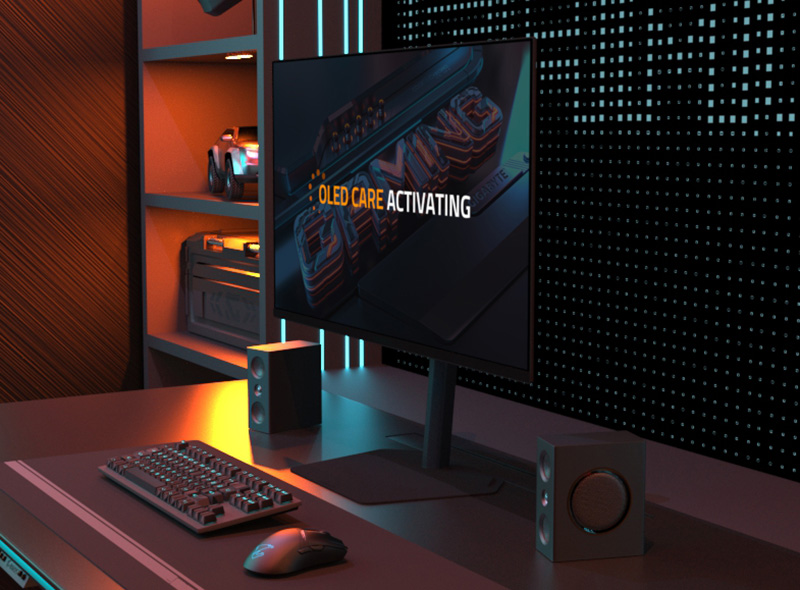
But it doesn’t just react—it remembers. As soon as your monitor is idle or switched off, AI OLED Care automatically runs pixel cleaning—all without interrupting your game or daily use.

To further help mitigate the risks of image retention, Gigabyte have added various thermal management approaches. They already have years of expertise in thermal management, crafting a high-efficiency cooling system specifically designed for gamers. Their cooling approach ensures that the monitor remains stable, cool, and durable. The screen includes features like a custom heatsink, graphene thermal film and four-sided ventilation, all of which means they don’t need to use active cooling fans in their monitors.

The screen is also backed by a 3-year warranty which includes burn-in cover for added peace of mind.
Tactical Gaming features

Gigabyte have also added loads of “AI Tactical” features and gaming functions to their new monitors, functions that can do things like auto-switch the picture mode and control things like crosshairs and black equalizer dynamically to enhance your gaming experience. These include:
- Tactical Switch 2.0 – allowing you to switch resolutions and screen sizes instantly with one click

- AI Picture Mode – this function automatically switches to the most suitable display setting for your current usage. Whether you’re watching movies, gaming, or working, the system intelligently detects on-screen content and automatically enhances clarity, brightness and eye strain.
- AI Black Equalizer – intelligently detects dark areas in the scene and brightens them without overexposing brighter regions.
- AI Crosshair – Your crosshair shows up right when you need it, no buttons, no delay.
- Nigh Vision – Enhances visibility across the entire screen, allowing FPS players to easily spot enemies in dark environments.
A new smaller, low-profile stand

Their new M series monitors feature a new metal stand design as well, with a very thin profile but a strong and sturdy support for the panel. This provides a small but strong footprint for the new screen, giving you more desktop room for your keyboard and mouse and other peripherals.
Connectivity and other features
The MO27Q28G offers DisplayPort 1.4, HDMI 2.1 and USB type-C (with DP Alt mode and 18W power delivery) connections for video. Picture in Picture (PiP) and Picture by Picture (PbP) modes are supported for handling multiple video inputs on the screen.
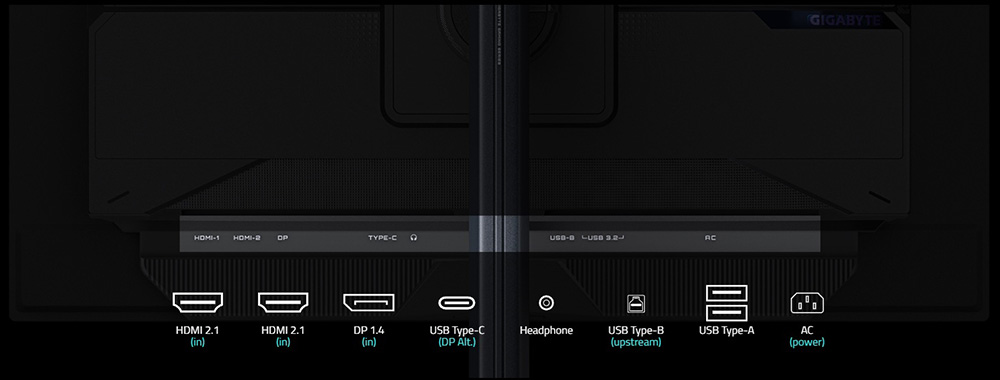
There’s also 2x USB data ports and a headphone jack, along with integrated 2x 5W speakers for audio. A KVM switch function is supported for controlling two systems from a single keyboard and mouse setup. The stand offers a full range of tilt, height, swivel and rotate adjustments.
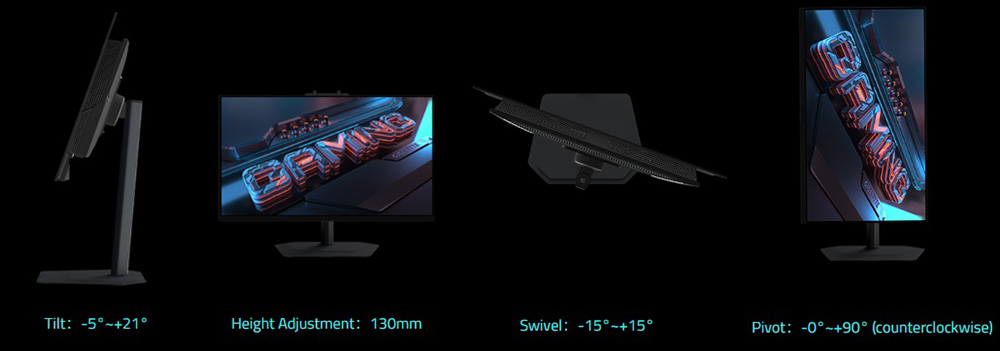
Pricing and availability
Update 27/8/25 – Gigabyte have further elaborated on the planned release schedule and pricing for this screen. While the planned global release date is the 30th September 2025 as we were previously informed, the actual in-store availability will vary by region depending on shipping and stocking schedules. It’s likely that some Asian countries will receive the first actual stock around end of Sept, with other regions expected to follow around Mid-October, or perhaps even later depending on shipping and supply. Pre-orders could be available in some regions and from some retailers too after the 30th September.
The global MSRP is going to be $549 USD we are told, but it’s expected to be available at launch at a promotional price of $499 USD (before tax / VAT etc) in some places. Pricing will be determined by each region and could vary with impacts of things like tariffs and VAT for instance. We’ll provide links to where you can buy/pre-order this screen when we see it become available so you can check final pricing and dates for your region.
Our full review of the Gigabyte MO27Q28G is also now available here.

Other Future 4th Gen WOLED Panels
This 27″ 1440p 280Hz panel used for the Gigabyte MO27Q28G is the first of its kind to be produced in the monitor segment, but we know that LG.Display will be producing other options later on. In fact they’ve already confirmed the successful development of a 27″ 1440p panel with a super-high 540Hz refresh rate, including support for dual-mode 720p @ 720Hz.

There’s no official word from Gigabyte yet on their potential adoption of that panel, but given they’ve already adopted the first 280Hz panel we wouldn’t be surprised to see them announce something later in the year when that panel goes in to mass production. With a higher 540Hz refresh rate, that’s going to carry a much higher price tag and sit in the top-tier OLED segment for sure. This initial 280Hz panel is aimed at a lower price point, and for those who are perfectly happy with the already-very-impressive performance that 280Hz can offer.

No other 4th Gen WOLED panels have been announced at this time, but any future panels produced should be based on this updated technology, so in time we’d certainly expect to see more options launched. That will likely include updates and refreshes to their 32″, 34″, 39″ and 45″ panels. You can find a full run-down of LG.Display’s WOLED monitor panels, generations and roadmap that we know about so far in our video here.
Useful Related Content
- Our full review of the Gigabyte MO27Q28G is also now available here.
- Gen 4 LG.Display 2025 OLED Panels and Improvements (video)
- Gigabyte’s Awesome New Monitors Launched at Computex 2025
We may earn a commission if you purchase from our affiliate links in this article- TFTCentral is a participant in the Amazon Services LLC Associates Programme, an affiliate advertising programme designed to provide a means for sites to earn advertising fees by advertising and linking to Amazon.com, Amazon.co.uk, Amazon.de, Amazon.ca and other Amazon stores worldwide. We also participate in a similar scheme for Overclockers.co.uk, Newegg, Bestbuy , B&H and some manufacturers.
Stay Up To Date
 |  |  |  |
| Browser Alerts | Follow on X | Subscribe on YouTube | Support Us |
Popular Trending Articles
 The Best Black Friday Monitor Deals – 2025 Tracker November 26, 2025 Loads of great deals to be had on monitors for the Black Friday sales period across a range of retailers and brands. Check the best recommendations here
The Best Black Friday Monitor Deals – 2025 Tracker November 26, 2025 Loads of great deals to be had on monitors for the Black Friday sales period across a range of retailers and brands. Check the best recommendations here 4th Gen Primary RGB Tandem OLED Monitors Are Here! – Gigabyte MO27Q28G Showcase August 22, 2025 Explaining 4th Gen Primary RGB Tandem WOLED and it’s benefits and specs. Including a showcase of the Gigabyte MO27Q28G monitor
4th Gen Primary RGB Tandem OLED Monitors Are Here! – Gigabyte MO27Q28G Showcase August 22, 2025 Explaining 4th Gen Primary RGB Tandem WOLED and it’s benefits and specs. Including a showcase of the Gigabyte MO27Q28G monitor Gen 4 Samsung QD-OLED 2025 Panels and Improvements April 14, 2025 A complete look at Samsung Display’s latest QD-OLED updates and news for 2025 including new technologies, improvements and specs
Gen 4 Samsung QD-OLED 2025 Panels and Improvements April 14, 2025 A complete look at Samsung Display’s latest QD-OLED updates and news for 2025 including new technologies, improvements and specs Here’s Why You Should Only Enable HDR Mode on Your PC When You Are Viewing HDR Content May 31, 2023 Looking at a common area of confusion and the problems with SDR, desktop and normal content when running in HDR mode all the time
Here’s Why You Should Only Enable HDR Mode on Your PC When You Are Viewing HDR Content May 31, 2023 Looking at a common area of confusion and the problems with SDR, desktop and normal content when running in HDR mode all the time QD-OLED Generations Infographic and FAQ June 17, 2025 A handy infographic explaining all QD-OLED panel generations along with answers to frequently asked questions
QD-OLED Generations Infographic and FAQ June 17, 2025 A handy infographic explaining all QD-OLED panel generations along with answers to frequently asked questions
